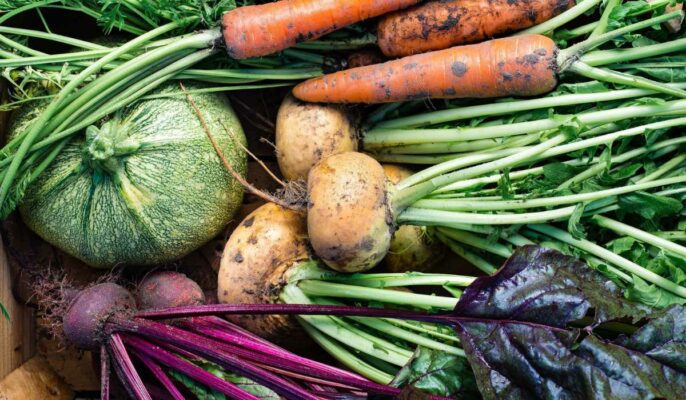Country Diary: The Edible Root Vegetable Cousin Of The Carrot

Table of Contents
A Closer Look at Parsnips: History and Origins
Parsnips, with their creamy texture and unique flavor, have a rich history interwoven with human civilization. Their story begins in the Mediterranean region, where evidence suggests they were cultivated as early as the first century AD. Ancient Greeks and Romans incorporated parsnips into their diets, appreciating their nutritional value and distinctive taste.
- Origins in the Mediterranean region: Early cultivation traces back to the eastern Mediterranean.
- Popular in ancient Greece and Rome: Parsnips held a place in the culinary traditions of these influential civilizations.
- Cultivation spread throughout Europe: Over time, the cultivation of parsnips expanded across Europe, adapting to various climates and soil conditions.
- Use in medieval and early modern cuisine: Parsnips featured prominently in medieval and early modern European cookbooks, demonstrating their enduring appeal.
- Increased popularity in recent times due to renewed interest in heritage vegetables: A growing appreciation for traditional and locally-sourced foods has fueled a resurgence in parsnip popularity. This renewed interest highlights the parsnip's unique contribution to a healthy and diverse diet.
Cultivating Parsnips: A Gardener's Guide
Growing your own parsnips can be a rewarding experience, bringing the earthy sweetness of this root vegetable directly from your garden to your table. However, success depends on careful preparation and attention to detail.
- Well-drained soil is crucial: Parsnips require loose, well-drained soil free of stones. Compacted soil will result in misshapen, forked roots.
- Planting depth and spacing: Plant parsnip seeds about 1 inch deep and 2-4 inches apart. Thin seedlings to allow for adequate spacing as they grow.
- Dealing with pests and diseases (e.g., carrot root flies): Carrot root flies are a common pest. Use netting to protect plants or consider companion planting with herbs like rosemary or onions.
- Optimal harvesting time for different parsnip varieties: Harvesting time varies depending on the variety, typically between late autumn and early winter. Wait until the leaves begin to yellow and wilt.
- Storage tips for fresh parsnips: Store harvested parsnips in a cool, dark, and well-ventilated place, ideally in a root cellar or refrigerator. They can also be stored in slightly damp sand or sawdust.
Nutritional Powerhouse: Health Benefits of Parsnips
Beyond their delicious flavor, parsnips are nutritional powerhouses, offering a range of health benefits.
- Rich in fiber: Parsnips are an excellent source of dietary fiber, promoting healthy digestion and regularity.
- Excellent source of Vitamin C: This crucial vitamin supports the immune system and acts as a powerful antioxidant.
- Contains potassium and folate: Potassium is essential for maintaining healthy blood pressure, while folate plays a vital role in cell growth and development.
- Antioxidants contribute to overall health: Parsnips contain various antioxidants that help protect cells from damage caused by free radicals.
- Low glycemic index, making them suitable for diabetics: Their low glycemic index makes them a suitable carbohydrate source for individuals managing diabetes.
Parsnip Recipes and Culinary Uses: Beyond the Roast
While roasted parsnips are a classic and delicious side dish, this versatile root vegetable offers a world of culinary possibilities.
- Parsnip soup recipes: Creamy parsnip soup is a comforting and flavorful option, easily customizable with herbs and spices.
- Parsnip fries or chips: Thinly sliced parsnips make delicious and healthy fries or chips, offering a delightful alternative to potato fries.
- Parsnip puree or mash: Parsnip puree or mash provides a smooth, subtly sweet alternative to mashed potatoes, perfect as a side dish or ingredient in other recipes.
- Parsnips in stews and casseroles: Their earthy flavor complements a variety of stews and casseroles, adding depth and richness.
- Adding parsnips to salads (raw or roasted): Raw, thinly sliced parsnips add a refreshing crunch to salads, while roasted parsnips offer a sweeter, more intense flavor.
- Unique parsnip-based desserts (e.g., parsnip cake): Yes, you can even bake with parsnips! Their subtle sweetness makes them a surprising yet delicious addition to cakes and other desserts.
Conclusion
From their humble beginnings to their present-day resurgence, parsnips offer a delightful blend of flavor and nutrition. This Country Diary has shown you just how versatile and beneficial this often-overlooked root vegetable can be. So, why not embrace the earthy sweetness of the parsnip and discover a new favorite ingredient? Explore parsnip recipes today and unlock the delicious potential of this edible cousin of the carrot!

Featured Posts
-
 Exploring Dara O Briains Voice Of Reason A Critical Look At His Career
May 30, 2025
Exploring Dara O Briains Voice Of Reason A Critical Look At His Career
May 30, 2025 -
 Gisele Pelicots Memoir An Hbo Adaptation
May 30, 2025
Gisele Pelicots Memoir An Hbo Adaptation
May 30, 2025 -
 San Diego International Airport Flight Delays What You Need To Know
May 30, 2025
San Diego International Airport Flight Delays What You Need To Know
May 30, 2025 -
 Alcaraz From Behind To Champion In Monte Carlo
May 30, 2025
Alcaraz From Behind To Champion In Monte Carlo
May 30, 2025 -
 Tsitsipas Addresses Reports Linking Him To Ivanisevic
May 30, 2025
Tsitsipas Addresses Reports Linking Him To Ivanisevic
May 30, 2025
Latest Posts
-
 Understanding Elevated Stock Market Valuations A Bof A Perspective
May 31, 2025
Understanding Elevated Stock Market Valuations A Bof A Perspective
May 31, 2025 -
 High Stock Valuations And Investor Confidence A Bof A Analysis
May 31, 2025
High Stock Valuations And Investor Confidence A Bof A Analysis
May 31, 2025 -
 Addressing Investor Concerns Bof A On Elevated Stock Market Valuations
May 31, 2025
Addressing Investor Concerns Bof A On Elevated Stock Market Valuations
May 31, 2025 -
 Stock Market Valuations Bof As Argument For Why Investors Shouldnt Worry
May 31, 2025
Stock Market Valuations Bof As Argument For Why Investors Shouldnt Worry
May 31, 2025 -
 Successfully Applying For Private Credit Jobs A 5 Point Guide
May 31, 2025
Successfully Applying For Private Credit Jobs A 5 Point Guide
May 31, 2025
